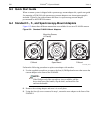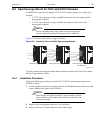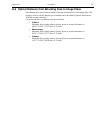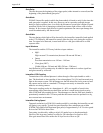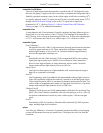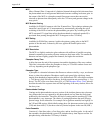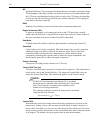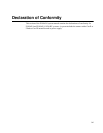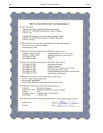
Appendix H Glossary 301
Gate Delay
The time between the beginning of the trigger pulse (either internal or external) and the
beginning of the photocathode gate pulse.
Gate Mode
PI-MAX4 intensifier mode in which the photocathode is biased on only for the time that
each gate pulse is applied. In this way, the array can be exposed to multiple images
during a single exposure time. As a result, the tolerance to room light is higher in gated
operation, but the risk of damaging overload from intense light sources such as lasers
remains. In fact, intense light sources in gated experiments can cause spot damage that
would be undetected by the alarm circuit.
Gate Width
The time during which light will be detected by the intensifier, intensified, and applied
to the CCD. Basically, the intensifier controls what the chip 'sees' during the exposure
time. For signal to be detected, it must both fall in a valid gate width and in a valid
exposure time.
Input Windows
The intensifier and the CCD array both have input windows.
• MgF
2
High vacuum UV transmission (between 100 nm and 200 nm.)
• Quartz
Excellent transmission over 190 nm - 1100 nm.
• Clear glass (BK7)
Visible (400 nm -700 nm) and NIR (700 nm - 2500 nm.)
Anti-Reflection (A/R) coatings may be added to input windows to reduce signal loss
and glare caused by reflection.
Intensifier-CCD Coupling
Transmission of the emitted photons is either through a fiber-optic bundle or with a
lens. The drawback to lens coupling is lower throughput (5%-10%) and increased stray
light in the camera system. The advantages are that the intensifier can be removed and
the camera can be used as a standard CCD imager conversely an intensifier can be
added to an existing camera.
Fiber-optic coupling results in a throughput of > 60%, are capable of sensitivities
approaching single-photoelectron detection, and have a much better signal-to-noise
ratio (SNR) than lens-coupled devices. Disadvantages are that the fiber-optic bundle is
permanently attached to the CCD array and that the camera must be operated in a dry,
non-vacuum inert environment.
Intensifier Gating Speed
Temporal resolution in a PI-MAX4 is made possible by switching the intensifier on and
off (gating) very rapidly. Typical fast-gate intensifiers have minimum gate widths
(FWHM=full width at half-maximum gate pulse) of approximately 2 ns. For slow-gated
devices the FWHM is about 50 ns.
Fast-gating is achieved by adding a nickel (Ni) under layer to the photocathode.
However, this layer may produce an effective QE reduction of as much as 40%.
Slow-gate intensifiers have neither the Ni layer nor its effects on QE.




